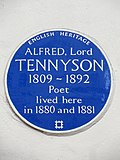Blue plaque

The blue plaque scheme is a way for remembering the links between famous people and buildings by placing commemorative plaques on the walls. The scheme was started by the Royal Society of Arts in London, and the very first plaques was, in fact, of red terracotta placed on the outside of a former home of Lord Byron (since demolished).
The Society erected 36 plaques between 1866 - 1901, responsibility for them was transferred to the London County Council (1901-65) (which changed the colour of the plaques to the current blue) and later the Greater London Council (1965-86) and most recently English Heritage. Similar schemes are now operated in all the member countries of the United Kingdom.
Outside London
English Heritage looks after the Blue plaque scheme in the London Boroughs. Similar schemes exist outside London, run by each local authority. [1]The system has been adopted outside the United Kingdom too, for example, in June 2010 a Blue Plaque was put on the home of Guernsey artist Peter Le Lievre.
Blue Plaque Media
English Heritage blue plaque at 9 Upper Belgrave Street, Belgravia, London, commemorating Poet Laureate Alfred, Lord Tennyson (erected 1994)
The blue plaque organised by the Nubian Jak Community Trust in partnership with the Mayor of London erected in 2006 to commemorate the flat at 34 Ridgmount Gardens in London, where reggae icon Bob Marley lived in 1972.
English Heritage blue plaque erected in 2009 at 91 Ashfield Street, Whitechapel, London commemorating Jack Cohen, founder of Tesco supermarkets.
English Heritage plaque at 40 Falkner Square, Liverpool, commemorating Peter Ellis, architect (erected 2001)
Greater London Council event plaque at Alexandra Palace, commemorating the launch of BBC Television in 1936 (erected 1977)
Society of Arts plaque on Samuel Johnson's house in Gough Square, London (erected 1876). Many of the early Society of Arts and LCC plaques were brown in colour.
London County Council bronze plaque in Canonbury Square, commemorating Samuel Phelps (erected 1901)
London County Council plaque at 48 Doughty Street, Holborn, commemorating Charles Dickens (erected 1903)
One of seven LCC Royal Doulton plaques with coloured laurel relief border erected in 1925; 41 Beak Street, Soho
London County Council plaque at 100 Lambeth Road, Lambeth, commemorating William Bligh (erected 1952)
References
- ↑ "English Heritage". www.english-heritage.org.uk.









